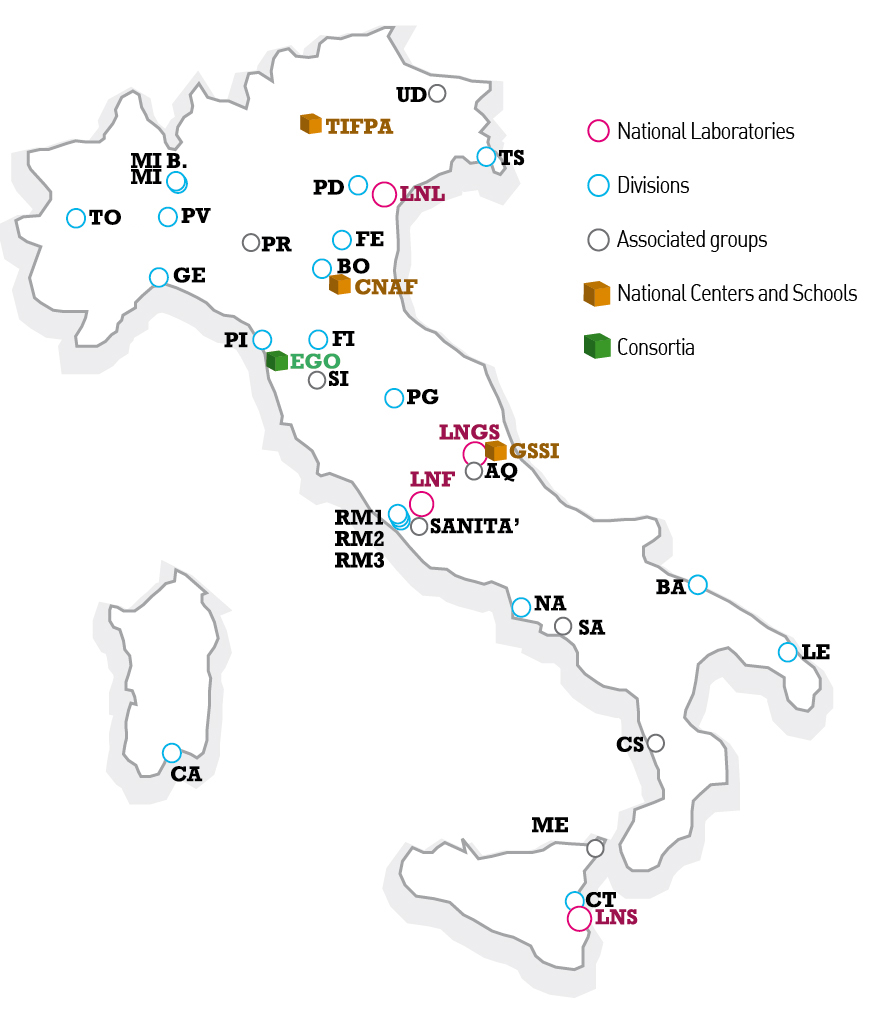TAsP
Theoretical Astroparticle Physics
| HOME | RESEARCH | TEAM | PUBLICATIONS | NEWS |
Scientific activities of the various Research Units
Ferrara (FE) node. Neutrinos: geoneutrinos with JUNO, 3D Earth crustal modeling centered on the detector area. Background to geoneutrino detection due to antineutrinos from nuclear power plants, periodically updated with operating plants and newly determined oscillation parameters. Evaporation of primordial BH as a source of BSM particle DM in the Universe. Contribution of this particle to dark radiation. (Meta)stability of the electroweak vacuum in the SM and beyond, and the study of the possible role of the Higgs boson in primordial inflation. Theoretical and phenomenological models of DM and their experimental tests.
Lecce (LE) node. Astrophysics: Study of second-order effects in gravitational microlensing; analysis of the X-ray source population, intermediate Mass BH in dwarf galaxies and globular clusters and correlation with catalogues in other wavelengths; constraints to the metric theories of gravity through pulsar timing and GW data; star formation in molecular clouds: individual and global properties of dense dust cores. Neutrino and axion physics: photon-axion and axion-like particles (ALPs) conversions in cluster, galactic and extragalactic magnetic fields and consequences for photon spectrum, polarization and cosmic transparency. Photon-ALP conversion and axion DM searches. Neutrino oscillations in astrophysical contexts and laboratory experiments. Search for NP in neutrino oscillation.
Lab. Naz. Frascati (LNF) node. Physics of the axions: theoretical models predicting non-canonical axion couplings to nucleons, electrons and photons, and their phenomenology; bounds from laboratory, astrophysical and cosmological observations. Physics of light DM candidates (dark photons, ALPs, sterile neutrinos) also in connection with the new dark-photon search experiment at LNF (PADME). Flavor symmetries in the neutrino sector and neutrino mass matrix models, and connections to lepton flavor violation. Flavour symmetries for the quark masses and CKM mixings. Generation of the cosmological matter-antimatter asymmetry via leptogenesis.
Lab. Naz. Gran Sasso (LNGS) node. Astrophysical Sources of radiation: High energy (HE) and Ultra HE (UHE) CRs, spectra and mass composition; UHE neutrinos and their detection in large volume detectors: search and identification of galactic and extragalactic sources with a multi-messenger approach. Neutrino Physics: supernova and solar neutrino physics; inference of the properties of the Sun from solar neutrino measurements. Particle and nuclear physics studies of neutrinoless double beta decay. Cosmology: Particle and nuclear physics studies of BBN.
Napoli (NA) node. BBN, with updated versions of the public code PArthENoPE; new bounds on the radiation content during BBN and study of the overall consistency of BBN and CMB; nonlinear evolution of perturbations. Models of DM-neutrino interactions; neutrino asymmetries; sterile neutrinos in the early universe. Sterile-active interactions via (pseudo) scalar mediators and their signatures in IceCube and GRAND experiments; gravitational effects on neutrino oscillations and violation of the equivalence principle; Cerenkov Telescope Array (CTA) potential for detecting Earth-skimming UHE tau neutrinos; models with extra charged W bosons and their signatures in ATLAS and CMS; determination of uncertainties on DM distribution in the MW; DM candidate signatures in CTA; DM distribution in galaxies using Machine Learning approaches; Wormholes, exotic matter and interacting quantum fields; Quantum tunneling and other applications of quantum field theory (QFT). Historical studies about Ettore Majorana.
Padova (PD) node. DM candidates from particle physics. Novel strategies for DM detection. Novel frameworks to produce DM in the early universe. New light particle physics to address the Hubble tension. Stochastic GW background from parity violating interactions in the early universe. Observational consequences of PBH. Reconstructing the thermal history through features in the primordial GW spectrum. Signature of ALPs in lepton flavor violating processes. Impact of light DM particles on precision measurements. Global analysis of all short baseline neutrino data. Sterile neutrino cosmology.
Pisa (PI) node. Theoretical stellar physics: evolution history of our Galaxy, protostellar and Pre-Main Sequence theoretical models and models of stellar population synthesis. Participation to GAIA-ESO Collaboration for high resolution spectroscopic analysis of stars. Stellar populations in dwarf galaxy satellites: record of early dynamical interactions. Ages of field stars from asteroseismic data, very low mass stars research for the future PLATO mission. Theoretical cosmology: general relativistic effects in LSS and CMB Radiation surveys. Backreaction of gauge fields on inflationary dynamics and production of PBH. Second order tensor perturbations at gravitational detectors. High energy CRs propagation from nearby sources and in the whole Galaxy. Diffuse gamma-ray emission from the galactic plane.
Roma 1 (RM1) node. Cosmology: solutions for the tension on the Hubble constant measured from CMB and luminosity distance; large scale structure, weak lensing (Euclid) and BBN data in a variety of cosmological models, in particular with nonstandard neutrino properties (extra sterile states, large lepton asymmetry). Modified gravity, coupled DM-DE, non-flat universe, CMB spectral distortions and implications for early universe physics. Inflationary models from constraints achievable from future CMB measurements.
Torino (TO) node DM: Cross-correlation studies of anisotropies in LSS and cosmic shear (sensitive to DM structures) with unresolved gamma-ray emission from the same LSS, and extension to other wavelength (radio, infrared). DM studies in the X-ray band. Phenomenology of DM candidates in the context of BSM theories. Multi-messenger astronomy with pulsars as antimatter sources in the Galaxy. Hadronic cross sections for the production of CRs, and their connection with collider experiments. Statistical analysis of Fermi-LAT count maps to identify the very faint sources of gamma-ray emission and exploit possible DM signals, in particular at the galactic center. Cosmological bounds on light particles (dark radiation and DM). Neutrinos: global data analysis of active-sterile oscillations, including cosmological bounds; study of electromagnetic properties of neutrinos. Phenomenology of coherent elastic neutrino-nucleus scattering.
detection searches.
